Financial Accounting Report: Purpose, Stakeholders, and Clients
VerifiedAdded on 2020/12/26
|25
|7840
|446
Report
AI Summary
This report delves into the realm of financial accounting, commencing with a comprehensive definition of the subject and an exploration of its fundamental purpose within business organizations. It meticulously outlines the significance of financial accounting, particularly in the context of large business entities and limited companies, emphasizing its role in reporting financial performance to stakeholders. The report then categorizes and elucidates the roles of both internal and external stakeholders, providing insights into their respective interests and influence. Furthermore, the document includes detailed journal entries and ledger accounts for multiple clients, offering practical examples of accounting procedures. The report touches upon key accounting concepts such as the double-entry system and the importance of financial statements. Overall, the report provides a practical overview of financial accounting principles and their application. The report also includes a discussion of the role of financial accounting in decision making and compliance with regulations.
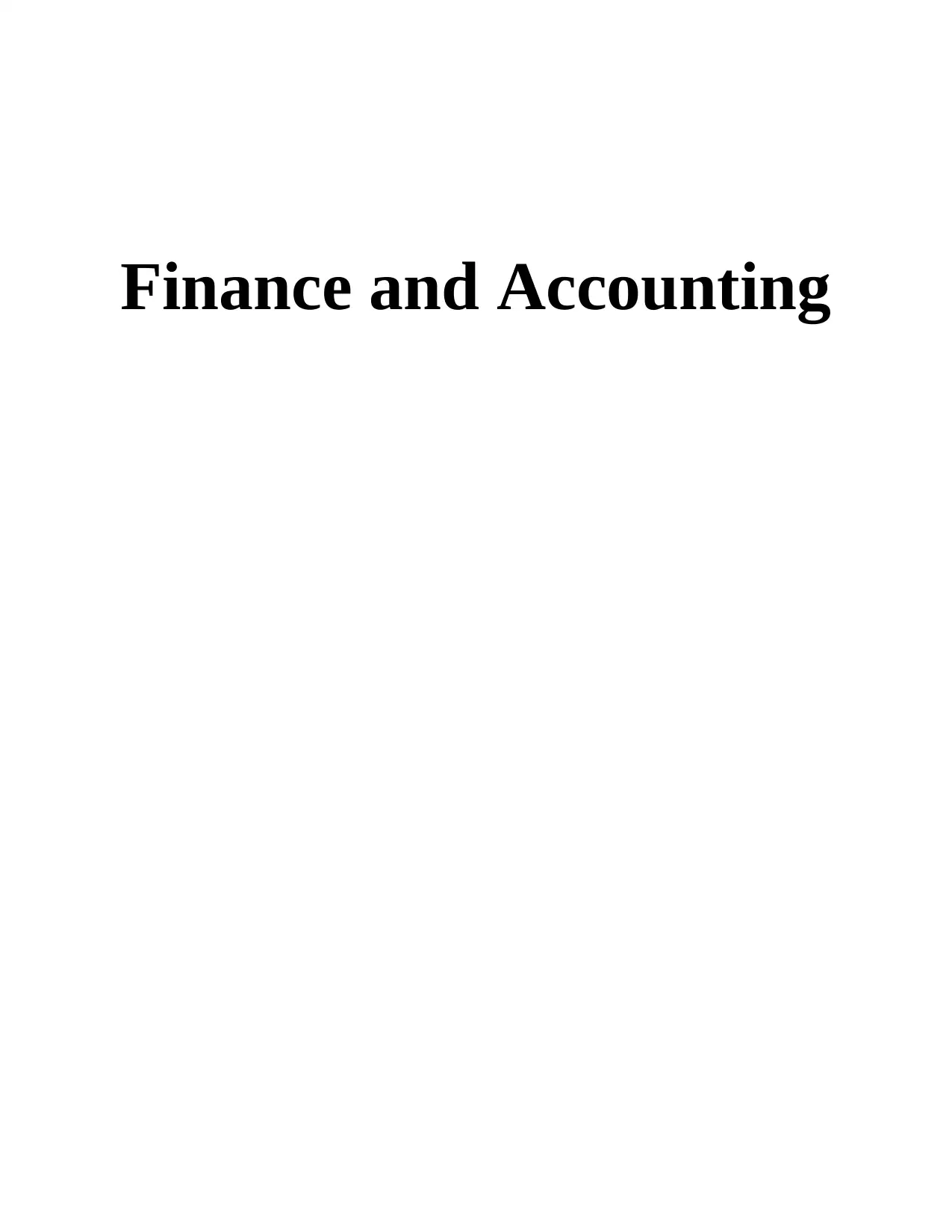
Finance and Accounting
Paraphrase This Document
Need a fresh take? Get an instant paraphrase of this document with our AI Paraphraser
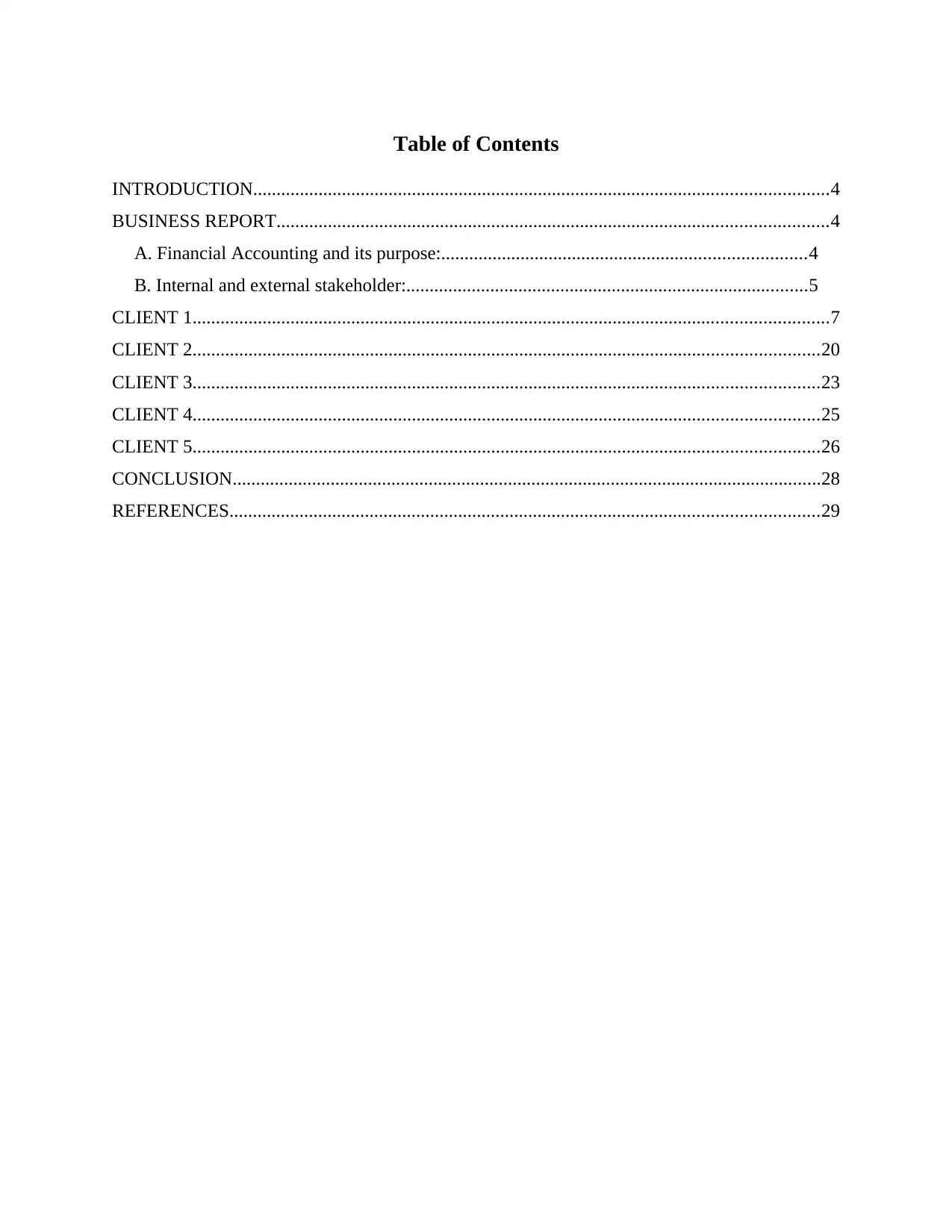
Table of Contents
INTRODUCTION...........................................................................................................................4
BUSINESS REPORT......................................................................................................................4
A. Financial Accounting and its purpose:..............................................................................4
B. Internal and external stakeholder:......................................................................................5
CLIENT 1........................................................................................................................................7
CLIENT 2......................................................................................................................................20
CLIENT 3......................................................................................................................................23
CLIENT 4......................................................................................................................................25
CLIENT 5......................................................................................................................................26
CONCLUSION..............................................................................................................................28
REFERENCES..............................................................................................................................29
INTRODUCTION...........................................................................................................................4
BUSINESS REPORT......................................................................................................................4
A. Financial Accounting and its purpose:..............................................................................4
B. Internal and external stakeholder:......................................................................................5
CLIENT 1........................................................................................................................................7
CLIENT 2......................................................................................................................................20
CLIENT 3......................................................................................................................................23
CLIENT 4......................................................................................................................................25
CLIENT 5......................................................................................................................................26
CONCLUSION..............................................................................................................................28
REFERENCES..............................................................................................................................29

⊘ This is a preview!⊘
Do you want full access?
Subscribe today to unlock all pages.

Trusted by 1+ million students worldwide
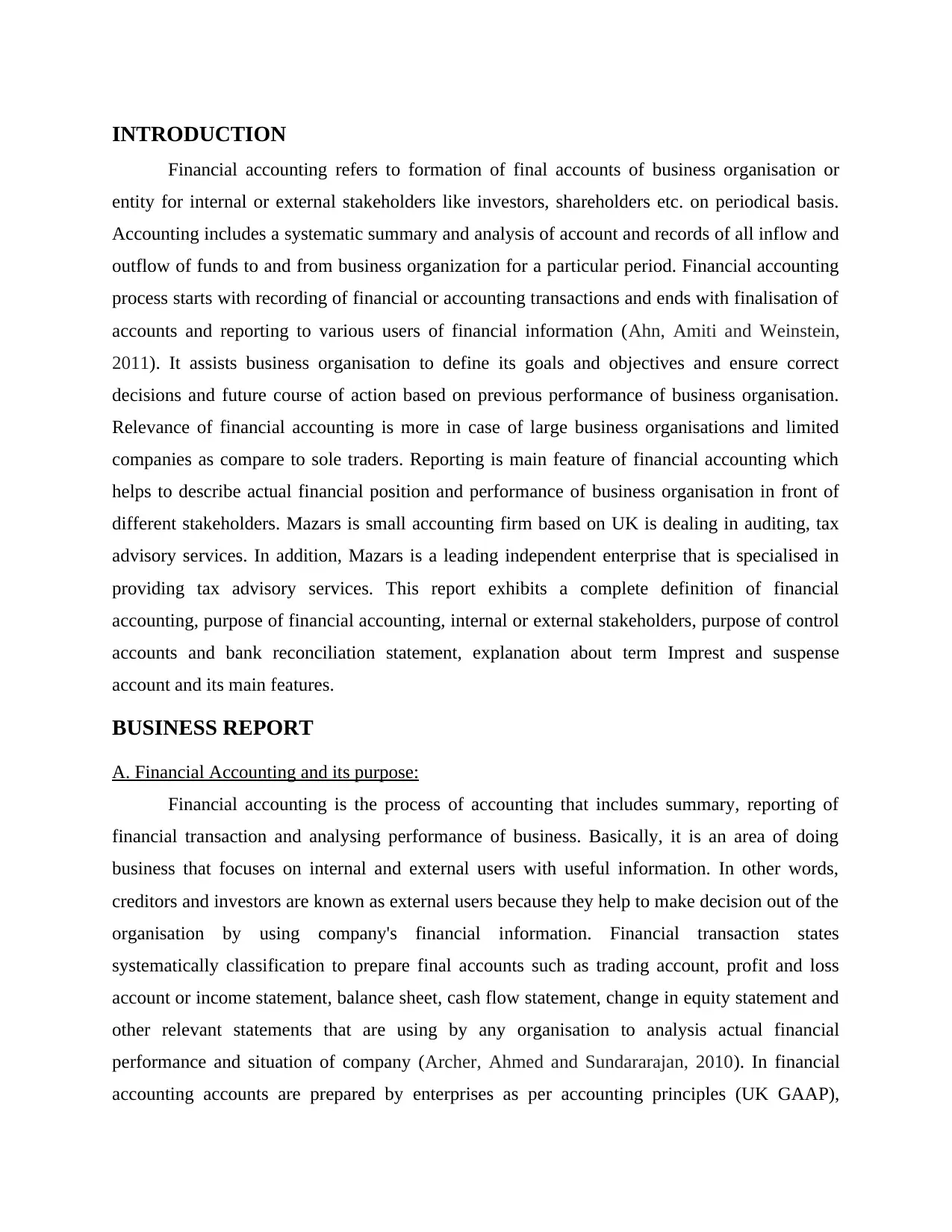
INTRODUCTION
Financial accounting refers to formation of final accounts of business organisation or
entity for internal or external stakeholders like investors, shareholders etc. on periodical basis.
Accounting includes a systematic summary and analysis of account and records of all inflow and
outflow of funds to and from business organization for a particular period. Financial accounting
process starts with recording of financial or accounting transactions and ends with finalisation of
accounts and reporting to various users of financial information (Ahn, Amiti and Weinstein,
2011). It assists business organisation to define its goals and objectives and ensure correct
decisions and future course of action based on previous performance of business organisation.
Relevance of financial accounting is more in case of large business organisations and limited
companies as compare to sole traders. Reporting is main feature of financial accounting which
helps to describe actual financial position and performance of business organisation in front of
different stakeholders. Mazars is small accounting firm based on UK is dealing in auditing, tax
advisory services. In addition, Mazars is a leading independent enterprise that is specialised in
providing tax advisory services. This report exhibits a complete definition of financial
accounting, purpose of financial accounting, internal or external stakeholders, purpose of control
accounts and bank reconciliation statement, explanation about term Imprest and suspense
account and its main features.
BUSINESS REPORT
A. Financial Accounting and its purpose:
Financial accounting is the process of accounting that includes summary, reporting of
financial transaction and analysing performance of business. Basically, it is an area of doing
business that focuses on internal and external users with useful information. In other words,
creditors and investors are known as external users because they help to make decision out of the
organisation by using company's financial information. Financial transaction states
systematically classification to prepare final accounts such as trading account, profit and loss
account or income statement, balance sheet, cash flow statement, change in equity statement and
other relevant statements that are using by any organisation to analysis actual financial
performance and situation of company (Archer, Ahmed and Sundararajan, 2010). In financial
accounting accounts are prepared by enterprises as per accounting principles (UK GAAP),
Financial accounting refers to formation of final accounts of business organisation or
entity for internal or external stakeholders like investors, shareholders etc. on periodical basis.
Accounting includes a systematic summary and analysis of account and records of all inflow and
outflow of funds to and from business organization for a particular period. Financial accounting
process starts with recording of financial or accounting transactions and ends with finalisation of
accounts and reporting to various users of financial information (Ahn, Amiti and Weinstein,
2011). It assists business organisation to define its goals and objectives and ensure correct
decisions and future course of action based on previous performance of business organisation.
Relevance of financial accounting is more in case of large business organisations and limited
companies as compare to sole traders. Reporting is main feature of financial accounting which
helps to describe actual financial position and performance of business organisation in front of
different stakeholders. Mazars is small accounting firm based on UK is dealing in auditing, tax
advisory services. In addition, Mazars is a leading independent enterprise that is specialised in
providing tax advisory services. This report exhibits a complete definition of financial
accounting, purpose of financial accounting, internal or external stakeholders, purpose of control
accounts and bank reconciliation statement, explanation about term Imprest and suspense
account and its main features.
BUSINESS REPORT
A. Financial Accounting and its purpose:
Financial accounting is the process of accounting that includes summary, reporting of
financial transaction and analysing performance of business. Basically, it is an area of doing
business that focuses on internal and external users with useful information. In other words,
creditors and investors are known as external users because they help to make decision out of the
organisation by using company's financial information. Financial transaction states
systematically classification to prepare final accounts such as trading account, profit and loss
account or income statement, balance sheet, cash flow statement, change in equity statement and
other relevant statements that are using by any organisation to analysis actual financial
performance and situation of company (Archer, Ahmed and Sundararajan, 2010). In financial
accounting accounts are prepared by enterprises as per accounting principles (UK GAAP),
Paraphrase This Document
Need a fresh take? Get an instant paraphrase of this document with our AI Paraphraser
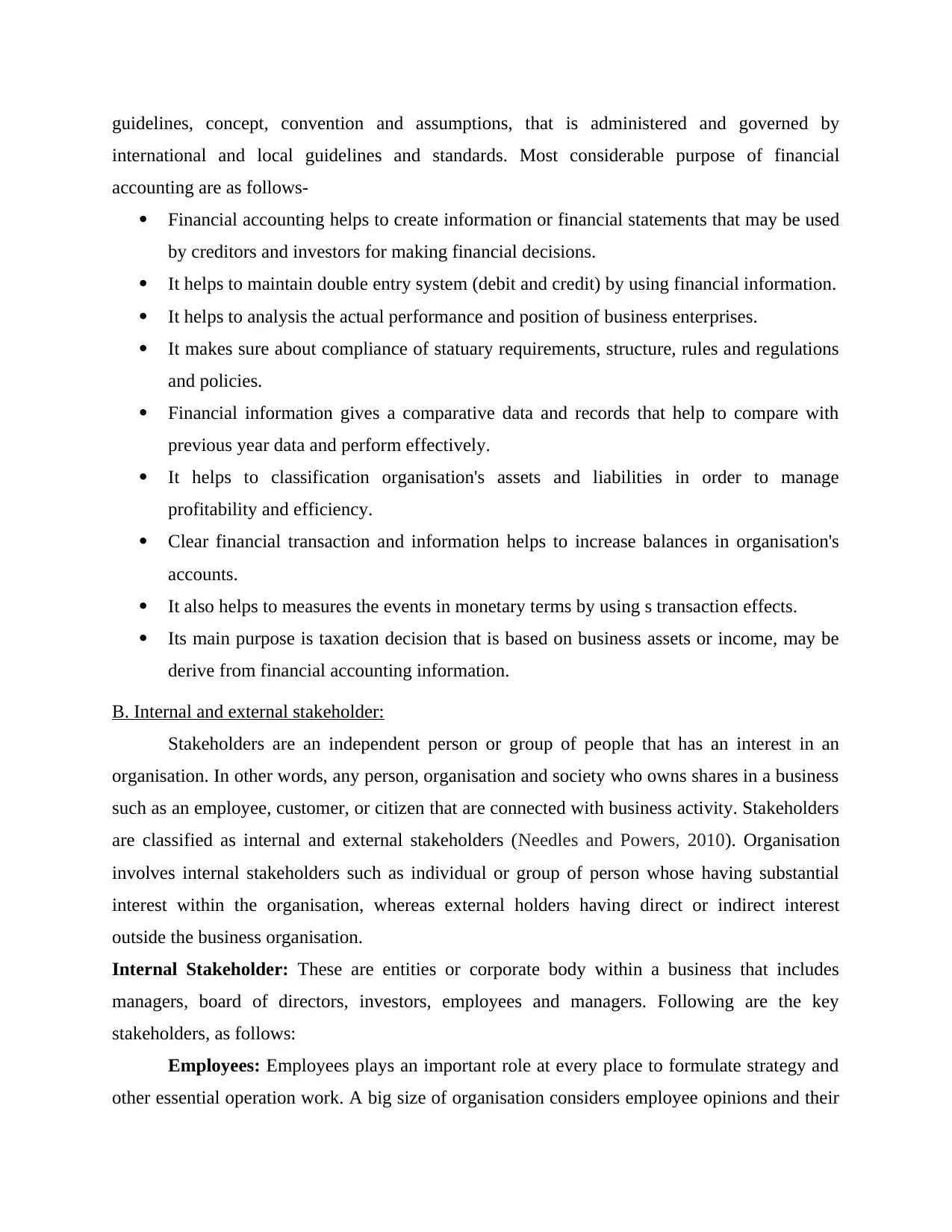
guidelines, concept, convention and assumptions, that is administered and governed by
international and local guidelines and standards. Most considerable purpose of financial
accounting are as follows-
Financial accounting helps to create information or financial statements that may be used
by creditors and investors for making financial decisions.
It helps to maintain double entry system (debit and credit) by using financial information.
It helps to analysis the actual performance and position of business enterprises.
It makes sure about compliance of statuary requirements, structure, rules and regulations
and policies.
Financial information gives a comparative data and records that help to compare with
previous year data and perform effectively.
It helps to classification organisation's assets and liabilities in order to manage
profitability and efficiency.
Clear financial transaction and information helps to increase balances in organisation's
accounts.
It also helps to measures the events in monetary terms by using s transaction effects.
Its main purpose is taxation decision that is based on business assets or income, may be
derive from financial accounting information.
B. Internal and external stakeholder:
Stakeholders are an independent person or group of people that has an interest in an
organisation. In other words, any person, organisation and society who owns shares in a business
such as an employee, customer, or citizen that are connected with business activity. Stakeholders
are classified as internal and external stakeholders (Needles and Powers, 2010). Organisation
involves internal stakeholders such as individual or group of person whose having substantial
interest within the organisation, whereas external holders having direct or indirect interest
outside the business organisation.
Internal Stakeholder: These are entities or corporate body within a business that includes
managers, board of directors, investors, employees and managers. Following are the key
stakeholders, as follows:
Employees: Employees plays an important role at every place to formulate strategy and
other essential operation work. A big size of organisation considers employee opinions and their
international and local guidelines and standards. Most considerable purpose of financial
accounting are as follows-
Financial accounting helps to create information or financial statements that may be used
by creditors and investors for making financial decisions.
It helps to maintain double entry system (debit and credit) by using financial information.
It helps to analysis the actual performance and position of business enterprises.
It makes sure about compliance of statuary requirements, structure, rules and regulations
and policies.
Financial information gives a comparative data and records that help to compare with
previous year data and perform effectively.
It helps to classification organisation's assets and liabilities in order to manage
profitability and efficiency.
Clear financial transaction and information helps to increase balances in organisation's
accounts.
It also helps to measures the events in monetary terms by using s transaction effects.
Its main purpose is taxation decision that is based on business assets or income, may be
derive from financial accounting information.
B. Internal and external stakeholder:
Stakeholders are an independent person or group of people that has an interest in an
organisation. In other words, any person, organisation and society who owns shares in a business
such as an employee, customer, or citizen that are connected with business activity. Stakeholders
are classified as internal and external stakeholders (Needles and Powers, 2010). Organisation
involves internal stakeholders such as individual or group of person whose having substantial
interest within the organisation, whereas external holders having direct or indirect interest
outside the business organisation.
Internal Stakeholder: These are entities or corporate body within a business that includes
managers, board of directors, investors, employees and managers. Following are the key
stakeholders, as follows:
Employees: Employees plays an important role at every place to formulate strategy and
other essential operation work. A big size of organisation considers employee opinions and their
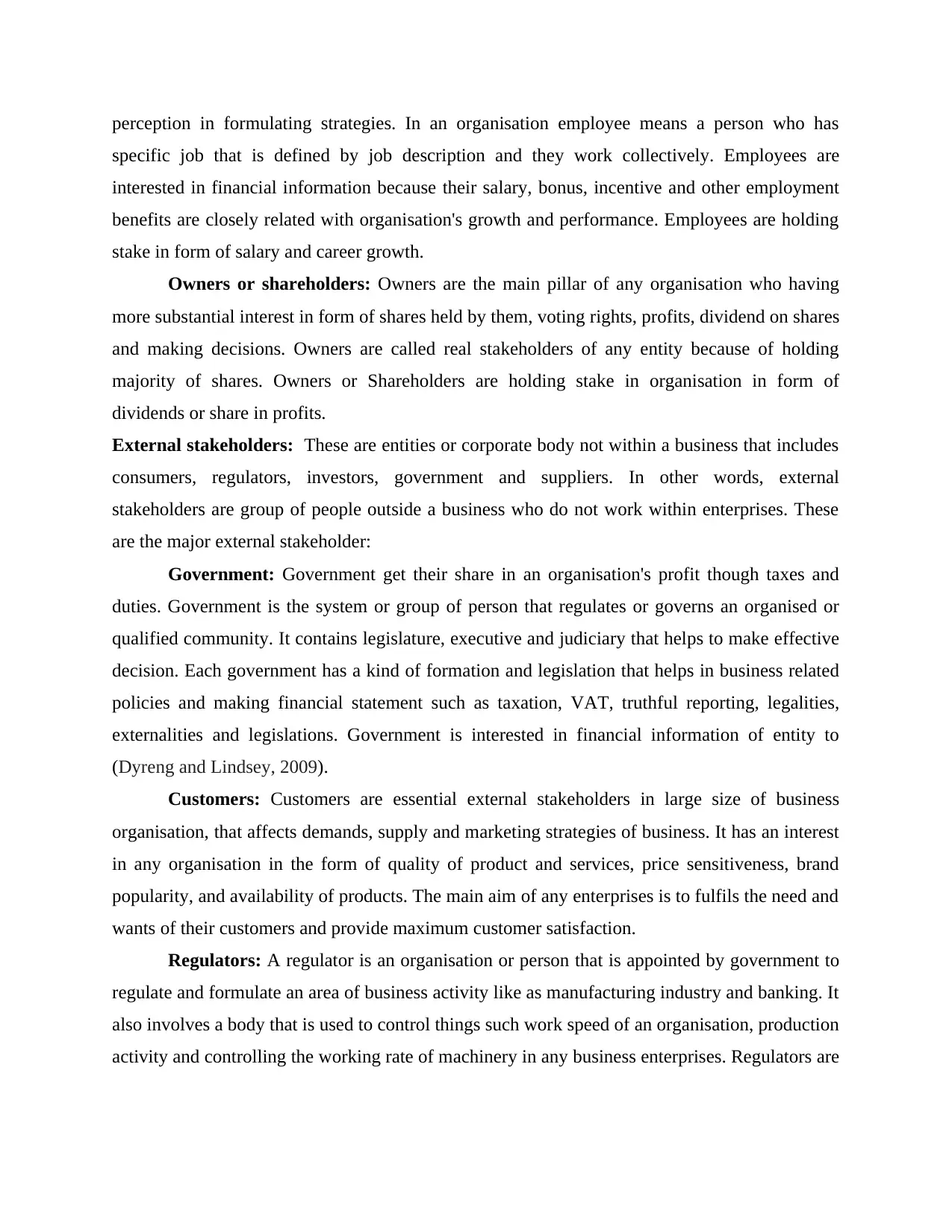
perception in formulating strategies. In an organisation employee means a person who has
specific job that is defined by job description and they work collectively. Employees are
interested in financial information because their salary, bonus, incentive and other employment
benefits are closely related with organisation's growth and performance. Employees are holding
stake in form of salary and career growth.
Owners or shareholders: Owners are the main pillar of any organisation who having
more substantial interest in form of shares held by them, voting rights, profits, dividend on shares
and making decisions. Owners are called real stakeholders of any entity because of holding
majority of shares. Owners or Shareholders are holding stake in organisation in form of
dividends or share in profits.
External stakeholders: These are entities or corporate body not within a business that includes
consumers, regulators, investors, government and suppliers. In other words, external
stakeholders are group of people outside a business who do not work within enterprises. These
are the major external stakeholder:
Government: Government get their share in an organisation's profit though taxes and
duties. Government is the system or group of person that regulates or governs an organised or
qualified community. It contains legislature, executive and judiciary that helps to make effective
decision. Each government has a kind of formation and legislation that helps in business related
policies and making financial statement such as taxation, VAT, truthful reporting, legalities,
externalities and legislations. Government is interested in financial information of entity to
(Dyreng and Lindsey, 2009).
Customers: Customers are essential external stakeholders in large size of business
organisation, that affects demands, supply and marketing strategies of business. It has an interest
in any organisation in the form of quality of product and services, price sensitiveness, brand
popularity, and availability of products. The main aim of any enterprises is to fulfils the need and
wants of their customers and provide maximum customer satisfaction.
Regulators: A regulator is an organisation or person that is appointed by government to
regulate and formulate an area of business activity like as manufacturing industry and banking. It
also involves a body that is used to control things such work speed of an organisation, production
activity and controlling the working rate of machinery in any business enterprises. Regulators are
specific job that is defined by job description and they work collectively. Employees are
interested in financial information because their salary, bonus, incentive and other employment
benefits are closely related with organisation's growth and performance. Employees are holding
stake in form of salary and career growth.
Owners or shareholders: Owners are the main pillar of any organisation who having
more substantial interest in form of shares held by them, voting rights, profits, dividend on shares
and making decisions. Owners are called real stakeholders of any entity because of holding
majority of shares. Owners or Shareholders are holding stake in organisation in form of
dividends or share in profits.
External stakeholders: These are entities or corporate body not within a business that includes
consumers, regulators, investors, government and suppliers. In other words, external
stakeholders are group of people outside a business who do not work within enterprises. These
are the major external stakeholder:
Government: Government get their share in an organisation's profit though taxes and
duties. Government is the system or group of person that regulates or governs an organised or
qualified community. It contains legislature, executive and judiciary that helps to make effective
decision. Each government has a kind of formation and legislation that helps in business related
policies and making financial statement such as taxation, VAT, truthful reporting, legalities,
externalities and legislations. Government is interested in financial information of entity to
(Dyreng and Lindsey, 2009).
Customers: Customers are essential external stakeholders in large size of business
organisation, that affects demands, supply and marketing strategies of business. It has an interest
in any organisation in the form of quality of product and services, price sensitiveness, brand
popularity, and availability of products. The main aim of any enterprises is to fulfils the need and
wants of their customers and provide maximum customer satisfaction.
Regulators: A regulator is an organisation or person that is appointed by government to
regulate and formulate an area of business activity like as manufacturing industry and banking. It
also involves a body that is used to control things such work speed of an organisation, production
activity and controlling the working rate of machinery in any business enterprises. Regulators are
⊘ This is a preview!⊘
Do you want full access?
Subscribe today to unlock all pages.

Trusted by 1+ million students worldwide
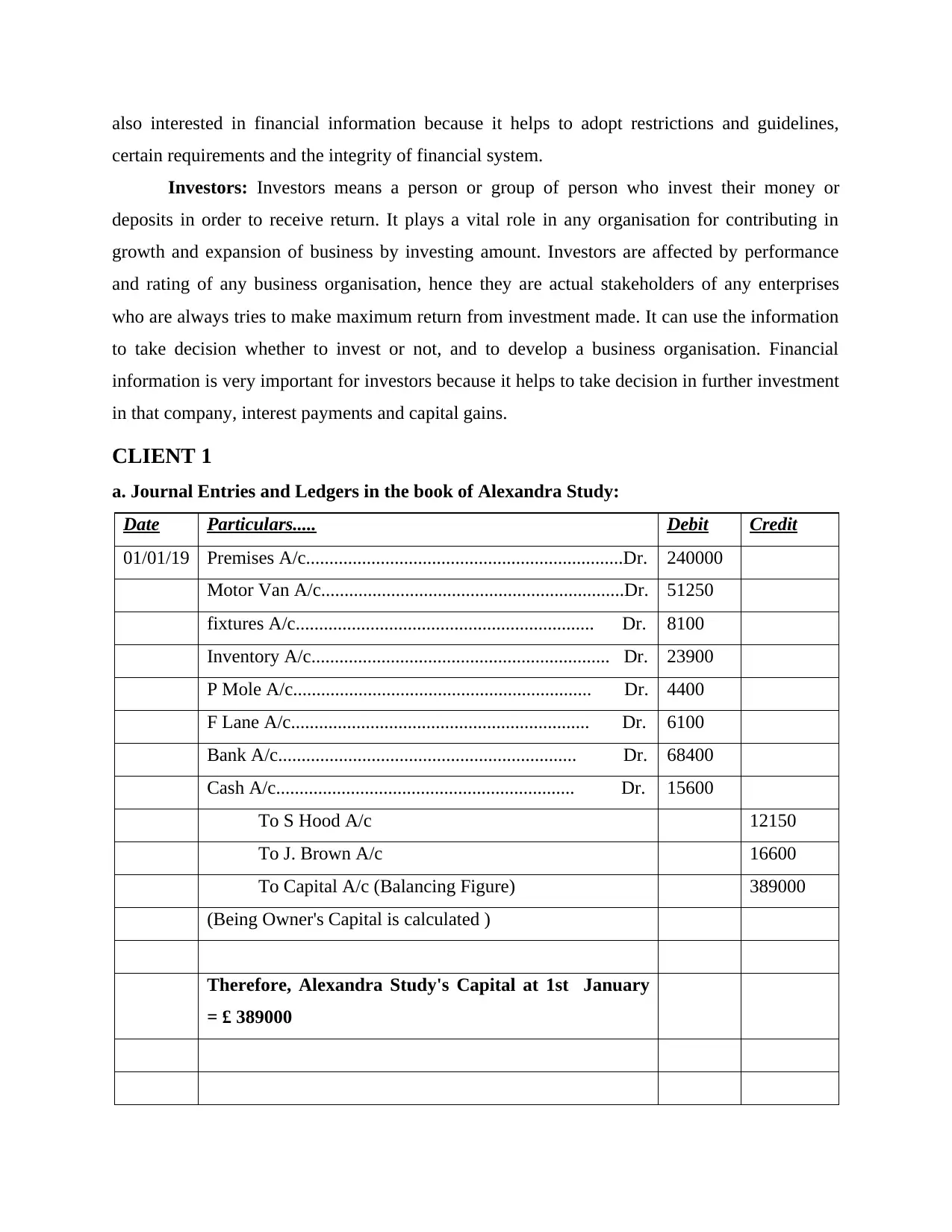
also interested in financial information because it helps to adopt restrictions and guidelines,
certain requirements and the integrity of financial system.
Investors: Investors means a person or group of person who invest their money or
deposits in order to receive return. It plays a vital role in any organisation for contributing in
growth and expansion of business by investing amount. Investors are affected by performance
and rating of any business organisation, hence they are actual stakeholders of any enterprises
who are always tries to make maximum return from investment made. It can use the information
to take decision whether to invest or not, and to develop a business organisation. Financial
information is very important for investors because it helps to take decision in further investment
in that company, interest payments and capital gains.
CLIENT 1
a. Journal Entries and Ledgers in the book of Alexandra Study:
Date Particulars..... Debit Credit
01/01/19 Premises A/c....................................................................Dr. 240000
Motor Van A/c.................................................................Dr. 51250
fixtures A/c................................................................ Dr. 8100
Inventory A/c................................................................ Dr. 23900
P Mole A/c................................................................ Dr. 4400
F Lane A/c................................................................ Dr. 6100
Bank A/c................................................................ Dr. 68400
Cash A/c................................................................ Dr. 15600
To S Hood A/c 12150
To J. Brown A/c 16600
To Capital A/c (Balancing Figure) 389000
(Being Owner's Capital is calculated )
Therefore, Alexandra Study's Capital at 1st January
= £ 389000
certain requirements and the integrity of financial system.
Investors: Investors means a person or group of person who invest their money or
deposits in order to receive return. It plays a vital role in any organisation for contributing in
growth and expansion of business by investing amount. Investors are affected by performance
and rating of any business organisation, hence they are actual stakeholders of any enterprises
who are always tries to make maximum return from investment made. It can use the information
to take decision whether to invest or not, and to develop a business organisation. Financial
information is very important for investors because it helps to take decision in further investment
in that company, interest payments and capital gains.
CLIENT 1
a. Journal Entries and Ledgers in the book of Alexandra Study:
Date Particulars..... Debit Credit
01/01/19 Premises A/c....................................................................Dr. 240000
Motor Van A/c.................................................................Dr. 51250
fixtures A/c................................................................ Dr. 8100
Inventory A/c................................................................ Dr. 23900
P Mole A/c................................................................ Dr. 4400
F Lane A/c................................................................ Dr. 6100
Bank A/c................................................................ Dr. 68400
Cash A/c................................................................ Dr. 15600
To S Hood A/c 12150
To J. Brown A/c 16600
To Capital A/c (Balancing Figure) 389000
(Being Owner's Capital is calculated )
Therefore, Alexandra Study's Capital at 1st January
= £ 389000
Paraphrase This Document
Need a fresh take? Get an instant paraphrase of this document with our AI Paraphraser
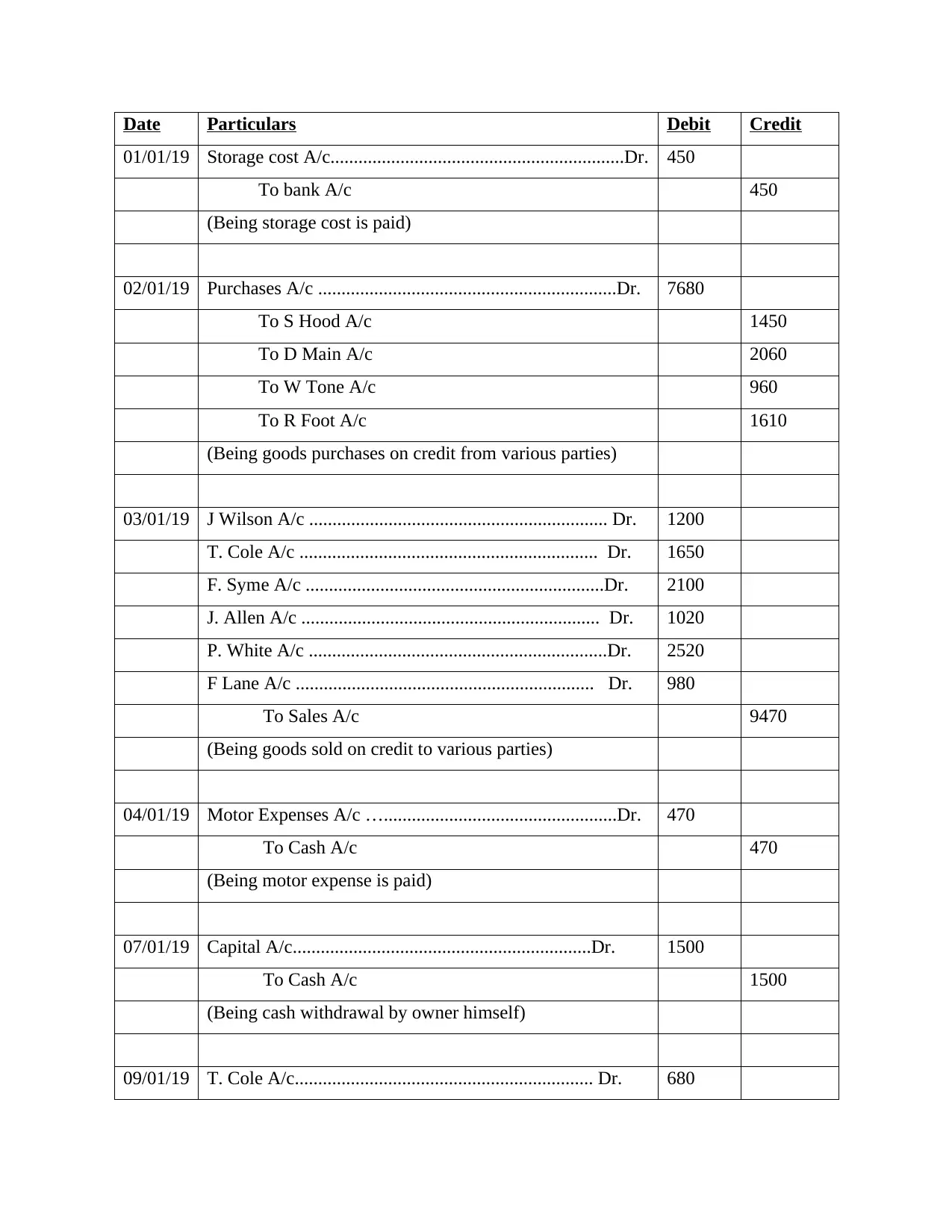
Date Particulars Debit Credit
01/01/19 Storage cost A/c...............................................................Dr. 450
To bank A/c 450
(Being storage cost is paid)
02/01/19 Purchases A/c ................................................................Dr. 7680
To S Hood A/c 1450
To D Main A/c 2060
To W Tone A/c 960
To R Foot A/c 1610
(Being goods purchases on credit from various parties)
03/01/19 J Wilson A/c ................................................................ Dr. 1200
T. Cole A/c ................................................................ Dr. 1650
F. Syme A/c ................................................................Dr. 2100
J. Allen A/c ................................................................ Dr. 1020
P. White A/c ................................................................Dr. 2520
F Lane A/c ................................................................ Dr. 980
To Sales A/c 9470
(Being goods sold on credit to various parties)
04/01/19 Motor Expenses A/c …..................................................Dr. 470
To Cash A/c 470
(Being motor expense is paid)
07/01/19 Capital A/c................................................................Dr. 1500
To Cash A/c 1500
(Being cash withdrawal by owner himself)
09/01/19 T. Cole A/c................................................................ Dr. 680
01/01/19 Storage cost A/c...............................................................Dr. 450
To bank A/c 450
(Being storage cost is paid)
02/01/19 Purchases A/c ................................................................Dr. 7680
To S Hood A/c 1450
To D Main A/c 2060
To W Tone A/c 960
To R Foot A/c 1610
(Being goods purchases on credit from various parties)
03/01/19 J Wilson A/c ................................................................ Dr. 1200
T. Cole A/c ................................................................ Dr. 1650
F. Syme A/c ................................................................Dr. 2100
J. Allen A/c ................................................................ Dr. 1020
P. White A/c ................................................................Dr. 2520
F Lane A/c ................................................................ Dr. 980
To Sales A/c 9470
(Being goods sold on credit to various parties)
04/01/19 Motor Expenses A/c …..................................................Dr. 470
To Cash A/c 470
(Being motor expense is paid)
07/01/19 Capital A/c................................................................Dr. 1500
To Cash A/c 1500
(Being cash withdrawal by owner himself)
09/01/19 T. Cole A/c................................................................ Dr. 680
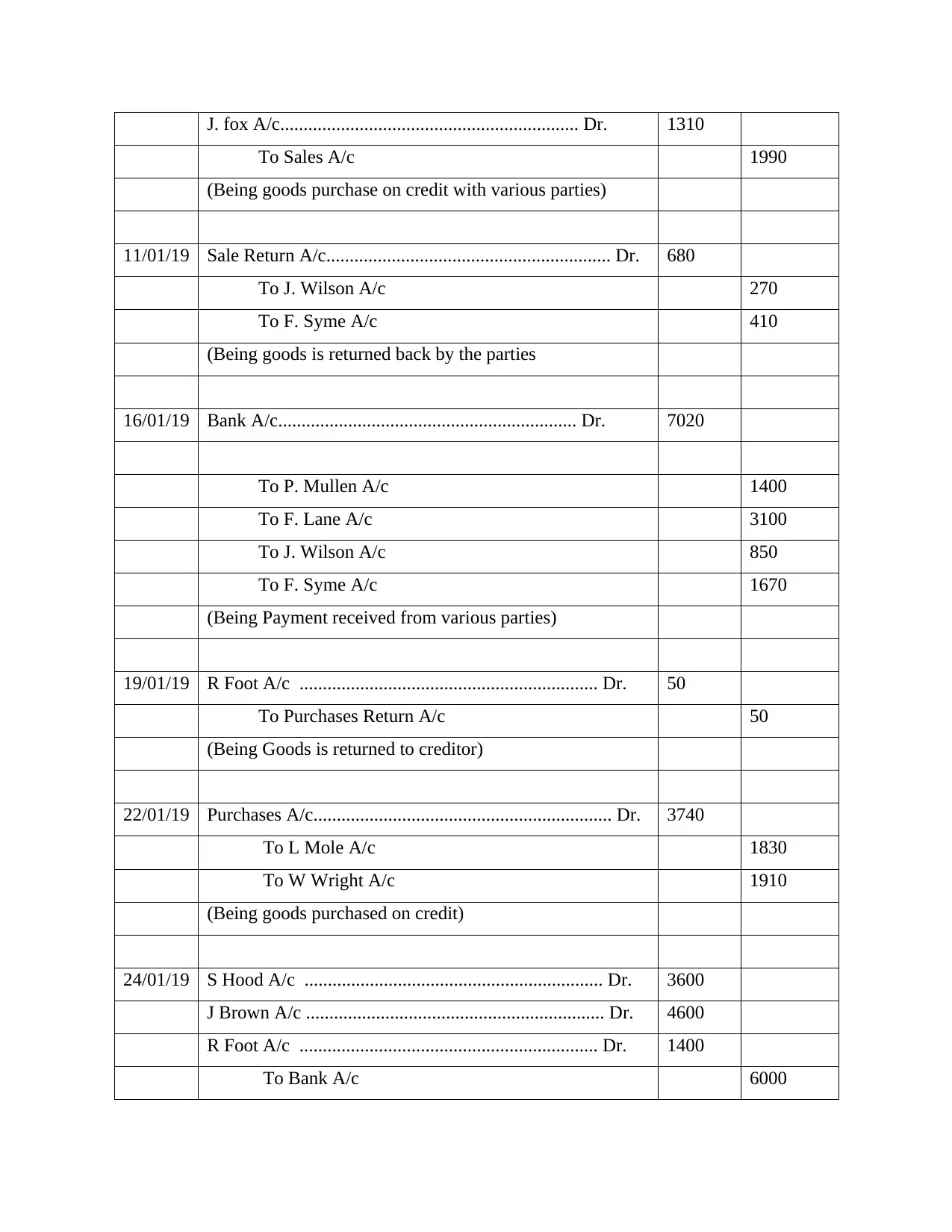
J. fox A/c................................................................ Dr. 1310
To Sales A/c 1990
(Being goods purchase on credit with various parties)
11/01/19 Sale Return A/c............................................................. Dr. 680
To J. Wilson A/c 270
To F. Syme A/c 410
(Being goods is returned back by the parties
16/01/19 Bank A/c................................................................ Dr. 7020
To P. Mullen A/c 1400
To F. Lane A/c 3100
To J. Wilson A/c 850
To F. Syme A/c 1670
(Being Payment received from various parties)
19/01/19 R Foot A/c ................................................................ Dr. 50
To Purchases Return A/c 50
(Being Goods is returned to creditor)
22/01/19 Purchases A/c................................................................ Dr. 3740
To L Mole A/c 1830
To W Wright A/c 1910
(Being goods purchased on credit)
24/01/19 S Hood A/c ................................................................ Dr. 3600
J Brown A/c ................................................................ Dr. 4600
R Foot A/c ................................................................ Dr. 1400
To Bank A/c 6000
To Sales A/c 1990
(Being goods purchase on credit with various parties)
11/01/19 Sale Return A/c............................................................. Dr. 680
To J. Wilson A/c 270
To F. Syme A/c 410
(Being goods is returned back by the parties
16/01/19 Bank A/c................................................................ Dr. 7020
To P. Mullen A/c 1400
To F. Lane A/c 3100
To J. Wilson A/c 850
To F. Syme A/c 1670
(Being Payment received from various parties)
19/01/19 R Foot A/c ................................................................ Dr. 50
To Purchases Return A/c 50
(Being Goods is returned to creditor)
22/01/19 Purchases A/c................................................................ Dr. 3740
To L Mole A/c 1830
To W Wright A/c 1910
(Being goods purchased on credit)
24/01/19 S Hood A/c ................................................................ Dr. 3600
J Brown A/c ................................................................ Dr. 4600
R Foot A/c ................................................................ Dr. 1400
To Bank A/c 6000
⊘ This is a preview!⊘
Do you want full access?
Subscribe today to unlock all pages.

Trusted by 1+ million students worldwide
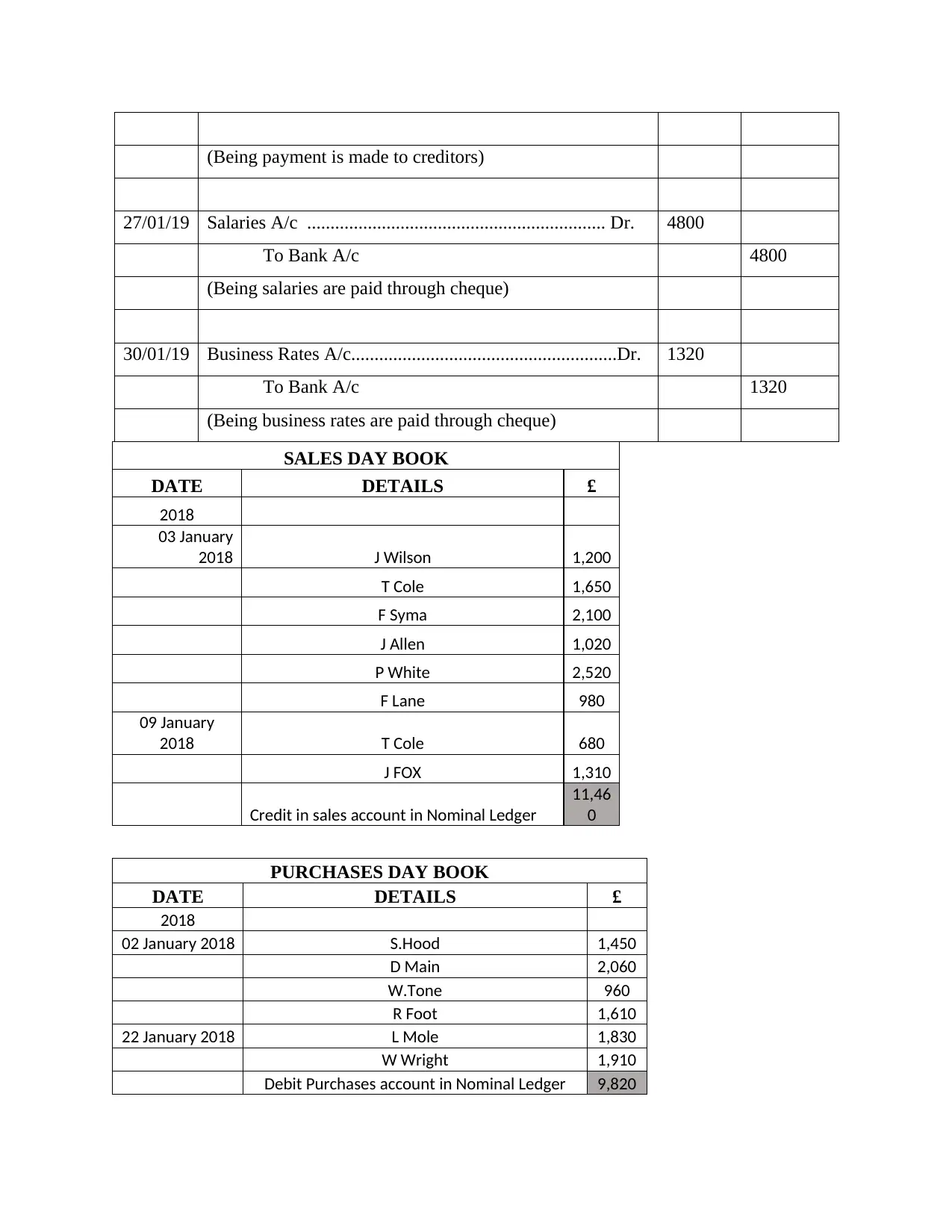
(Being payment is made to creditors)
27/01/19 Salaries A/c ................................................................ Dr. 4800
To Bank A/c 4800
(Being salaries are paid through cheque)
30/01/19 Business Rates A/c.........................................................Dr. 1320
To Bank A/c 1320
(Being business rates are paid through cheque)
SALES DAY BOOK
DATE DETAILS £
2018
03 January
2018 J Wilson 1,200
T Cole 1,650
F Syma 2,100
J Allen 1,020
P White 2,520
F Lane 980
09 January
2018 T Cole 680
J FOX 1,310
Credit in sales account in Nominal Ledger
11,46
0
PURCHASES DAY BOOK
DATE DETAILS £
2018
02 January 2018 S.Hood 1,450
D Main 2,060
W.Tone 960
R Foot 1,610
22 January 2018 L Mole 1,830
W Wright 1,910
Debit Purchases account in Nominal Ledger 9,820
27/01/19 Salaries A/c ................................................................ Dr. 4800
To Bank A/c 4800
(Being salaries are paid through cheque)
30/01/19 Business Rates A/c.........................................................Dr. 1320
To Bank A/c 1320
(Being business rates are paid through cheque)
SALES DAY BOOK
DATE DETAILS £
2018
03 January
2018 J Wilson 1,200
T Cole 1,650
F Syma 2,100
J Allen 1,020
P White 2,520
F Lane 980
09 January
2018 T Cole 680
J FOX 1,310
Credit in sales account in Nominal Ledger
11,46
0
PURCHASES DAY BOOK
DATE DETAILS £
2018
02 January 2018 S.Hood 1,450
D Main 2,060
W.Tone 960
R Foot 1,610
22 January 2018 L Mole 1,830
W Wright 1,910
Debit Purchases account in Nominal Ledger 9,820
Paraphrase This Document
Need a fresh take? Get an instant paraphrase of this document with our AI Paraphraser
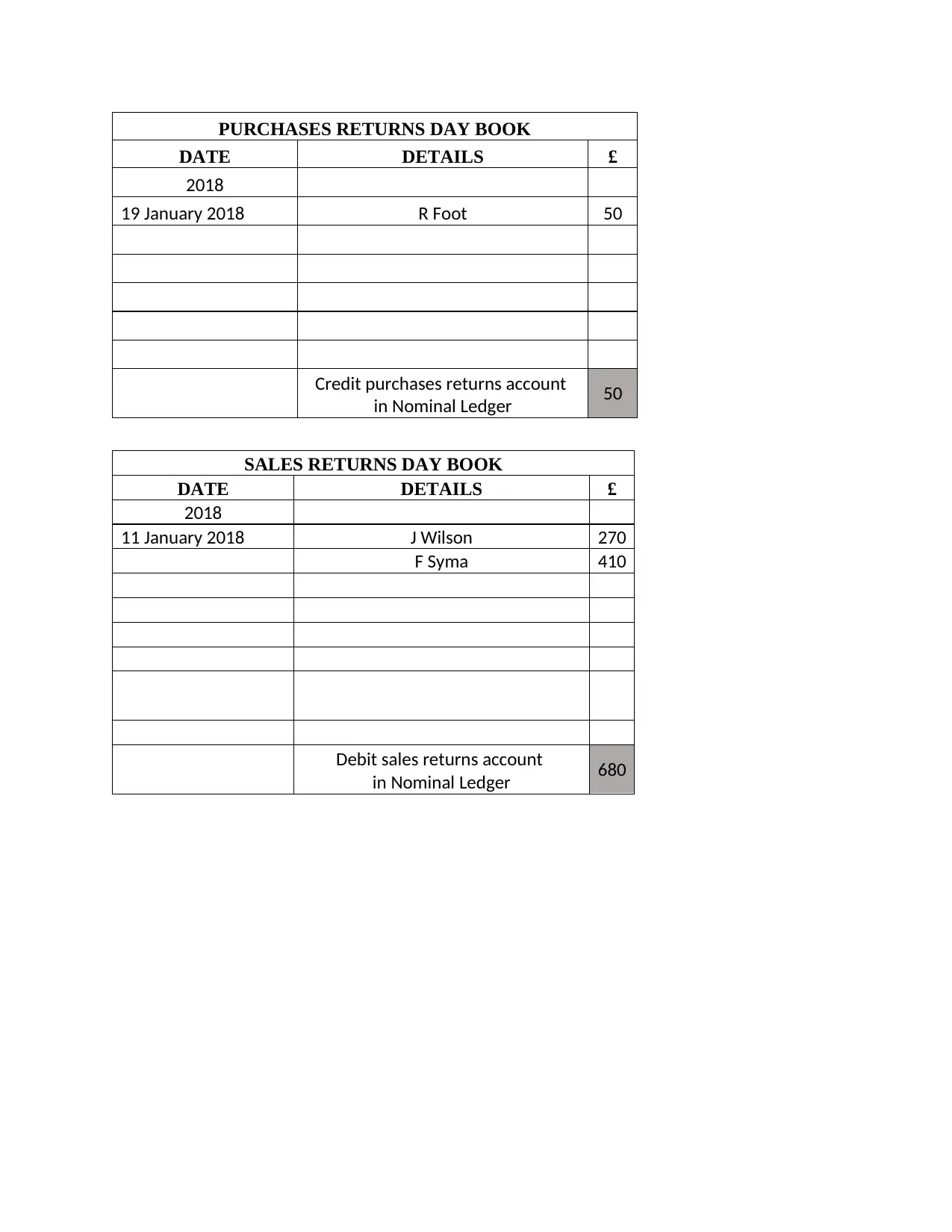
PURCHASES RETURNS DAY BOOK
DATE DETAILS £
2018
19 January 2018 R Foot 50
Credit purchases returns account
in Nominal Ledger 50
SALES RETURNS DAY BOOK
DATE DETAILS £
2018
11 January 2018 J Wilson 270
F Syma 410
Debit sales returns account
in Nominal Ledger 680
DATE DETAILS £
2018
19 January 2018 R Foot 50
Credit purchases returns account
in Nominal Ledger 50
SALES RETURNS DAY BOOK
DATE DETAILS £
2018
11 January 2018 J Wilson 270
F Syma 410
Debit sales returns account
in Nominal Ledger 680
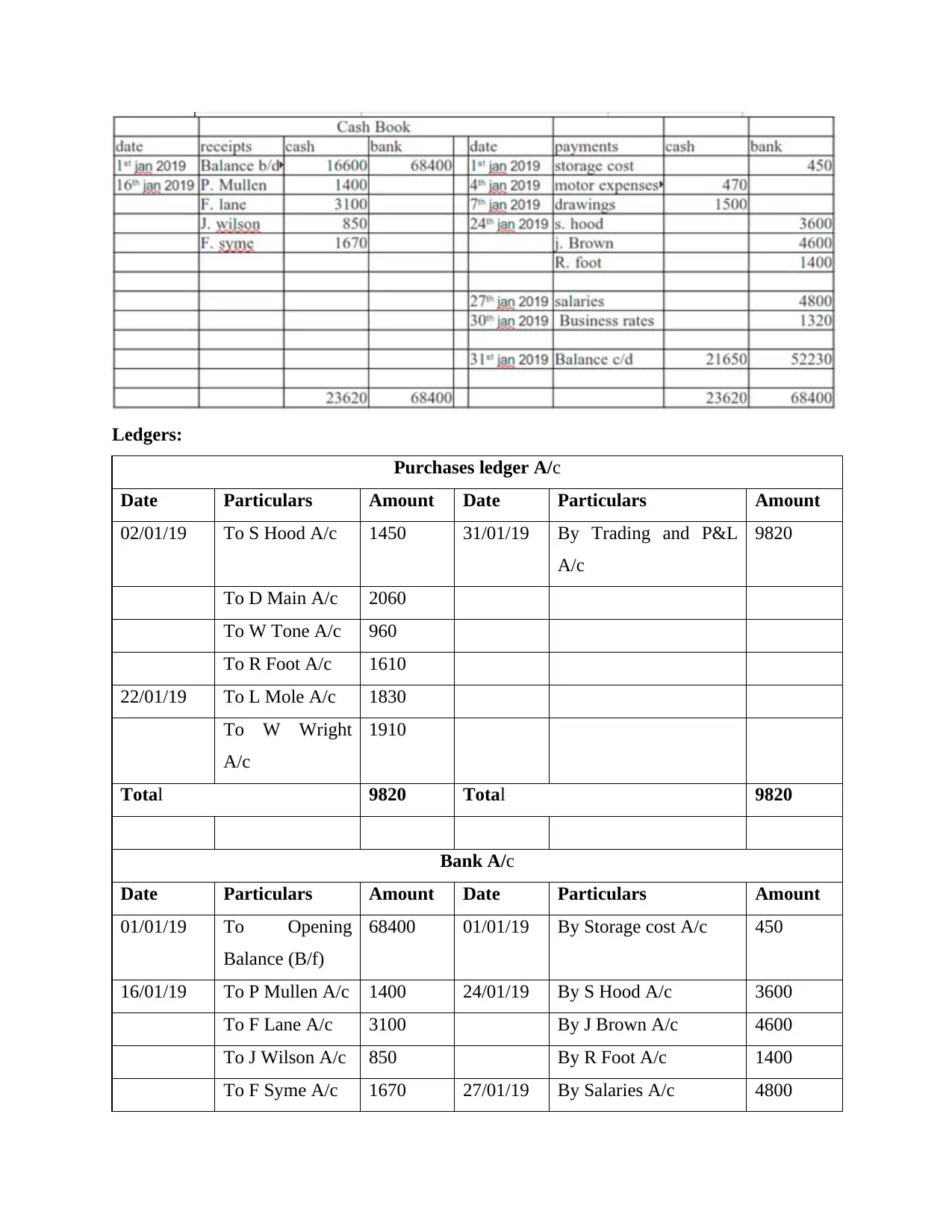
Ledgers:
Purchases ledger A/c
Date Particulars Amount Date Particulars Amount
02/01/19 To S Hood A/c 1450 31/01/19 By Trading and P&L
A/c
9820
To D Main A/c 2060
To W Tone A/c 960
To R Foot A/c 1610
22/01/19 To L Mole A/c 1830
To W Wright
A/c
1910
Total 9820 Total 9820
Bank A/c
Date Particulars Amount Date Particulars Amount
01/01/19 To Opening
Balance (B/f)
68400 01/01/19 By Storage cost A/c 450
16/01/19 To P Mullen A/c 1400 24/01/19 By S Hood A/c 3600
To F Lane A/c 3100 By J Brown A/c 4600
To J Wilson A/c 850 By R Foot A/c 1400
To F Syme A/c 1670 27/01/19 By Salaries A/c 4800
Purchases ledger A/c
Date Particulars Amount Date Particulars Amount
02/01/19 To S Hood A/c 1450 31/01/19 By Trading and P&L
A/c
9820
To D Main A/c 2060
To W Tone A/c 960
To R Foot A/c 1610
22/01/19 To L Mole A/c 1830
To W Wright
A/c
1910
Total 9820 Total 9820
Bank A/c
Date Particulars Amount Date Particulars Amount
01/01/19 To Opening
Balance (B/f)
68400 01/01/19 By Storage cost A/c 450
16/01/19 To P Mullen A/c 1400 24/01/19 By S Hood A/c 3600
To F Lane A/c 3100 By J Brown A/c 4600
To J Wilson A/c 850 By R Foot A/c 1400
To F Syme A/c 1670 27/01/19 By Salaries A/c 4800
⊘ This is a preview!⊘
Do you want full access?
Subscribe today to unlock all pages.

Trusted by 1+ million students worldwide
1 out of 25
Related Documents
Your All-in-One AI-Powered Toolkit for Academic Success.
+13062052269
info@desklib.com
Available 24*7 on WhatsApp / Email
![[object Object]](/_next/static/media/star-bottom.7253800d.svg)
Unlock your academic potential
Copyright © 2020–2025 A2Z Services. All Rights Reserved. Developed and managed by ZUCOL.





